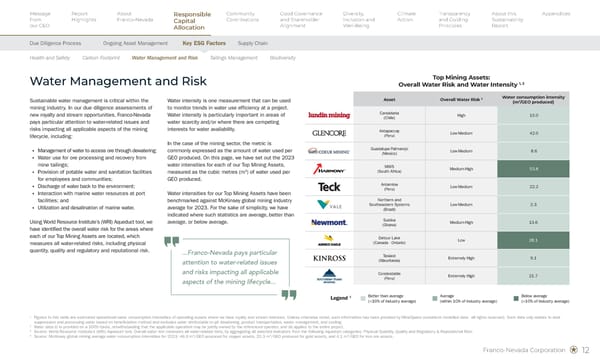Water Management and Risk
Franco-Nevada prioritizes sustainable water use, assessing risks across mining lifecycles and benchmarking asset water intensity using WRI tools and data.
Franco-Nevada Corporation 12 1 Figures in this table are estimated operational water consumption intensities of operating assets where we have royalty and stream interests. Unless otherwise noted, such information has been provided by MineSpans (outside-in modelled data - all rights reserved). Such data only relates to dust suppression and processing water based on beneficiation method and excludes water attributable to pit dewatering, product transportation, waste management, and cooling. 2 Water data (i) is provided on a 100% basis, notwithstanding that the applicable operation may be jointly owned by the referenced operator, and (ii) applies to the entire project. 3 Source: World Resource Institute’s (WRI) Aqueduct tool. Overall water risk measures all water-related risks, by aggregating all selected indicators from the following Aqueduct categories: Physical Quantity, Quality and Regulatory & Reputational Risk. 4 Source: McKinsey global mining average water consumption intensities for 2023: 46.9 m3/GEO produced for copper assets, 20.3 m3/GEO produced for gold assets, and 4.1 m3/GEO for iron ore assets. Sustainable water management is critical within the mining industry. In our due diligence assessments of new royalty and stream opportunities, Franco-Nevada pays particular attention to water-related issues and risks impacting all applicable aspects of the mining lifecycle, including: § Management of water to access ore through dewatering; § Water use for ore processing and recovery from mine tailings; § Provision of potable water and sanitation facilities for employees and communities; § Discharge of water back to the environment; § Interaction with marine water resources at port facilities; and § Utilization and desalination of marine water. Using World Resource Institute’s (WRI) Aqueduct tool, we have identified the overall water risk for the areas where each of our Top Mining Assets are located, which measures all water-related risks, including physical quantity, quality and regulatory and reputational risk. Water intensity is one measurement that can be used to monitor trends in water use efficiency at a project. Water intensity is particularly important in areas of water scarcity and/or where there are competing interests for water availability. In the case of the mining sector, the metric is commonly expressed as the amount of water used per GEO produced. On this page, we have set out the 2023 water intensities for each of our Top Mining Assets, measured as the cubic metres (m3) of water used per GEO produced. Water intensities for our Top Mining Assets have been benchmarked against McKinsey global mining industry average for 2023. For the sake of simplicity, we have indicated where such statistics are average, better than average, or below average. Water Management and Risk ...Franco-Nevada pays particular attention to water-related issues and risks impacting all applicable aspects of the mining lifecycle... Top Mining Assets: Overall Water Risk and Water Intensity 1, 2 Asset Overall Water Risk 3 Water consumption intensity (m3/GEO produced) Candelaria (Chile) High 15.0 Antapaccay (Peru) Low-Medium 42.0 Guadalupe-Palmarejo (Mexico) Low-Medium 8.6 MWS (South Africa) Medium-High 53.8 Antamina (Peru) Low-Medium 22.2 Northern and Southeastern Systems (Brazil) Low-Medium 2.3 Subika (Ghana) Medium-High 13.6 Detour Lake (Canada - Ontario) Low 28.1 Tasiast (Mauritania) Extremely High 9.1 Condestable (Peru) Extremely High 21.7 Legend 4 Better than average (10% of industry average) Responsible Capital Allocation Due Diligence Process Ongoing Asset Management Key ESG Factors Supply Chain Message from our CEO Report Highlights About Franco-Nevada Community Contributions Good Governance and Shareholder Alignment Diversity, Inclusion and Well-Being Transparency and Guiding Principles Climate Action About this Sustainability Report Appendices Health and Safety Carbon Footprint Water Management and Risk Tailings Management Biodiversity
 Sustainability Report 2025 Page 13 Page 15
Sustainability Report 2025 Page 13 Page 15